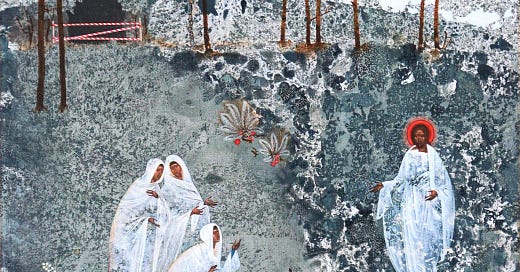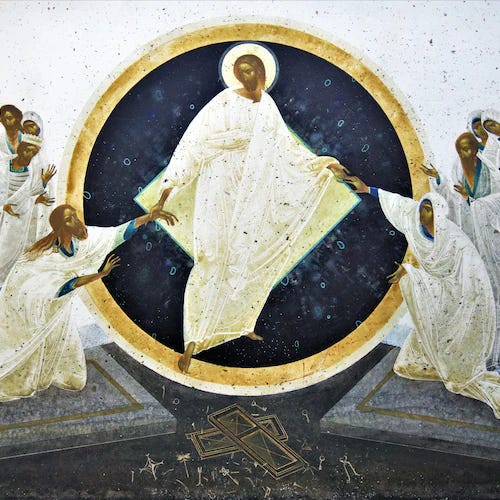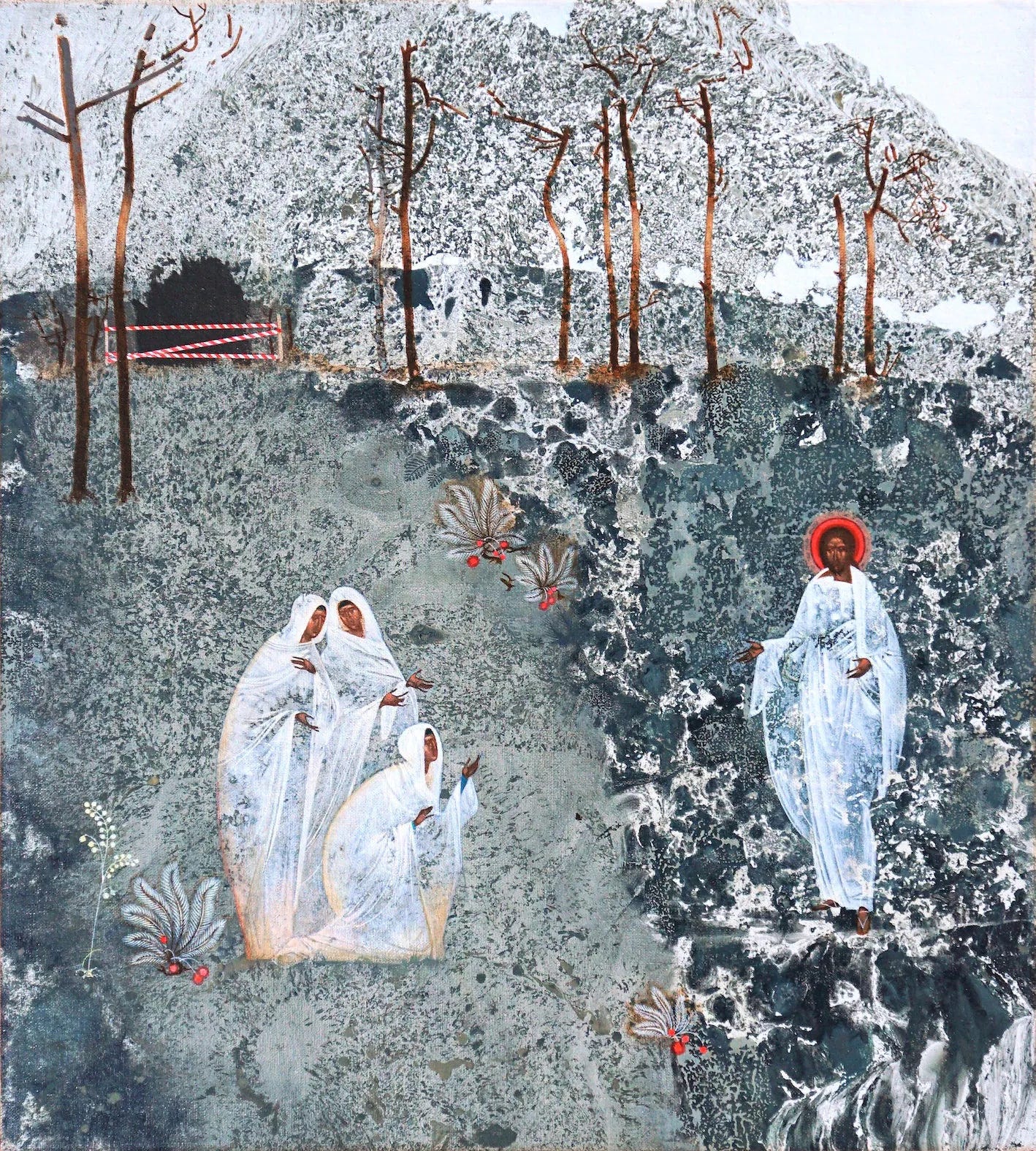John 20.1-18
Christ is Risen!
Christ is Risen indeed!
Alleluia!
The Lord Jesus is Risen indeed; however, lest we forget, Christ was not raised from attending a wedding in Cana. Nor was Jesus raised while throwing his temple tantrum or while sipping bourbon with sinners. Jesus was raised from corruption in the tomb, having first been inflicted a manner of death so ghastly the word crux was verboten in polite pagan society.
The context is critical for Easter’s intelligibility. Just so, in the ancient tradition of the church, Easter is inextricable from its antecedent events. Easter gets its coherence by of its continuity with Holy Saturday, when the God-who-is-human is dead in the tomb, and with Good Friday, when he is betrayed, condemned, and crucified. Historically, the Paschal Feast is called the Great Three Days, the days being undetachable from one another.
Thus, properly speaking, Easter begins in the dark between Thursday night and Friday morning, in the gloaming hours after Passover, when Caiphas’s municipal guard bring the bound and bleeding Jesus from Gethsemane on the Mount of Olives to the jail cell in the chief priest’s basement. The prison cell itself is a pit carved out of bedrock, about twenty-five feet deep. Just outside the chief priest’s palace is the exact spot where Peter stands by a charcoal fire and says, “Jesus? Jesus of Nazareth, you say? Never heard of him.”
The Gospels report that Jesus prays the twenty-second psalm from his cross, “My God, my God, why have you forsaken me?” The Gospels tells us Jesus prays Psalm 22, but I wonder if Jesus also prays eighty-eighth psalm while held in the dark stone hole of Caiphas’s basement:
“O lord God of my salvation, my soul is full of troubles: and my life draweth nigh unto the grave as I am counted with them that go down into the pit…”
In the first Gospel, Christ’s cry of dereliction is the only word he utters from the cross. As if, in the end, all that Jesus has to say from the cross is all we can say about the crucified Jesus: the God-who-is human has been forsaken.
Forsaken by the satanic marriage between Religion Inc. and Politics.
Forsaken by Pilate and the people of Abraham.
Forsaken by his friends.
Forsaken by us.
On Good Friday, the God-who-is human is forsaken. And no angel of the Lord appears to stay the blade in our hand. We did did not spare the Father’s only beloved Son. The Living God has an executioner. Such that, on Saturday, the Second Person of the Trinity is dead.
For the evening of Holy Saturday, as part of the ancient liturgy for the Easter Vigil, the church traditionally reads the Akedah, the story of the Binding of Isaac as found in the Book of Genesis:
“Take your son, your only son Isaac, whom you love, and go to the land of Moriah, and offer him there as a burnt-offering on one of the mountains that I shall show you.”
The primal church found the parallels between the Virgin Mary’s child and the unlikely son of the elderly Abraham and Sarah auspicious. But if Mary’s boy is Isaac in the scriptural analogy, the Father Almighty is not Father Abraham.
The one whom Jesus called Abba is not akin to Abraham. Jesus’s Father is not the one who binds his Son and nails him to a tree. We do. Thus, on Good Friday, a short walk from Mt. Moriah, where Abraham took his son Isaac to murder him to honor the Lord, we push the true God up a hill called Golgotha, carrying not a blade and wood for a fire but a hammer and nails. Golgotha is Mount Moriah without the ram in the bush or the angel rushing in to the rescue. Calvary is where the children of Abraham provide the innocent lamb for slaughter, another Father’s Son.
Good Friday is Abraham going through with it.
My God, my God, why do we forsake him?
The primal church found in the story of Abraham’s near sacrifice of Isaac a parallel to our sacrifice of the Father’s only begotten Son, which means it’s an analogy that applies to Easter Sunday as much as to Good Friday.
The Isaac story imaginatively opens up the Easter story.
So imagine.
Imagine that Abraham went through with the deed on Mt. Moriah.
Imagine he did it. Imagine Abraham closing his eyes and raising his arm and plunging the knife. Imagine his son Isaac’s scream and the silence that would follow it, save for the bleating of a lost and forgotten ram hidden amid the bushes.
Imagine Abraham making his three day trek down the mountain path back to Isaac’s mother. Imagine a stranger approaching Abraham’s campfire that first night. And, in the comfortable anonymity of the darkness, imagine Abraham confesses to this stranger his story about what he had believed god required, how it led him to violence and murder, how in his grief he knew now that heaven wept with him, how he had been blind and deaf, how his religious zeal really had been unfaith, how as he plunged the knife he realized he had confused the true God with his Adversary. Imagine Abraham spilling out his guilt and shame, and then realizing he’d not even asked for the stranger’s name.
“Tell me your name,” Abraham asks.
And the stranger lifts up his bowed head and pulls back his hood and replies, “Isaac. My name is Isaac.”
And then imagine Isaac showing Abraham his hands and his side.
He is Risen.
Isaac can help us begin to grasp the merciful surprise of Easter.
Peter thrice denied Jesus. Only Judas betrayed Jesus for spending money but none of Jesus’s friends attempted to buy his release. Mary Magdalene and John the Beloved Disciple, they did not shout, “Crucify him!” Yet neither did they shout,“Do NOT crucify him!”
All failed him.
But on the third day, “Isaac. My name is Isaac.”
The one whose side we pierced returns with an assurance of absolution. The one whom we forsook comes back with forgiveness. The Man of Sorrows we mocked on the cross is restored from it as once again the Man for Others.
Yet this surprising mercy— what the church calls grace— is not itself the mystery of Easter nor is it by itself the promise of Resurrection.
Forgiveness alone does not go far enough in expressing the hope of the Gospel which the scriptures give us.
The mystery of Easter is yet more incompressible. The promise of Resurrection is so surpassingly better than a merciful surprise.
The promise of Resurrection is so good you do not yet have a desire for it.
The mystery of Easter, the promise of Resurrection— it is here in our Gospel, hiding in plain sight. You can glimpse it if you defamiliarize yourself with the scripture and allow it to become strange again. Like Mary Magdalene, you must bend down to peer inside. That is to say, you cannot see it by standing as you’ve always stood.
Notice the all important detail John reports for you: the empty tomb isn’t.
The tomb is not empty!
Mary, John reports, stoops down to look into the tomb and inside the tomb sit what? Two angels. And— again the detail is everything— the first angel sits where? At the head of Christ’s grave slab. And the second angel sits where? At the foot of Jesus’s grave slab.
Thus, not only is the tomb not empty.
It’s no longer a tomb.
It’s a throne.
This is plainly visible to anyone familiar with the scriptures.
In the Book of Exodus, after the Lord rescues the Israelites through the Red Sea, the Lord journeys through the wilderness with his people, sheltered in the Mishkan, the tabernacle, and seated invisibly upon the Kapōreṯ, the mercy seat, the throne flanked at the head and the foot by two cherubim angels. This is the selfsame throne which resided in the Holy of Holies in the Jerusalem temple.
Throughout the scriptures, the cherubim flanking the ark, above and below, mark the spot where the Living God is locatable.
The true God, who himself cannot be seen, dwells in the space between the two cherubim.
To “see” the unseeable God is to gaze upon the space between the angels.
Not to see God here is to behold him enthroned in glory.
The tomb is not empty nor is it any longer a tomb.
It’s a throne.
Moreover, the space between the angels, in the tabernacle and the temple, is a throne always meant for the Son of Man. Nearly six centuries before Mary gives birth to Jesus, God gives the priest Ezekiel a vision as the context for his call to prophecy. God shows Ezekiel a heavenly prototype of the cherubim throne; that is, a vision of how the throne of God appears eternally.
And what does Ezekiel see?
Seated on the throne, charged with the glory that constitutes the throne, with an angel at his head and an angel at his feet, Ezekiel sees “a figure who has the appearance of a man.”
The man on the throne of God who shines with God’s own glory, who is God’s glory, is Jesus. The disciples on the Mount of Transfiguration simply caught a glimpse of who Jesus has always been in the Trinity. Five hundred and seventy years before Jesus is born Ezekiel sees what John shows you today, the Risen Jesus enthroned in the space between the angels.
He died between two thieves.
He’s been raised up and enthroned between two angels.
Easter is more mysterious than simply a merciful surprise.
The empty tomb is no longer a tomb. Nor is the tomb empty. The tomb is full.
The apparent emptiness signifies not the absence of the dead Jesus.
The apparent emptiness signifies the presence of the body of the Risen Christ.
Notice the detail John gives you.
First, Mary faces the tomb and addresses the angels, “They have taken away my Lord, and I do not know where they have laid him.” Next, verse fourteen, John tells you that Mary turns. Her back is to the tomb now. And Mary “sees” Jesus but she doesn’t recognize him as Jesus. Supposing him to be the gardener, she says to the man in front of her, “Sir, if you have taken him away, tell me where you have laid him, and I will take him away.”
And then— pay attention, John reports in verse sixteen that Jesus says to her, “Mary.”
And Mary turns, John says.
She turns in the direction of his voice.
She turns towards the tomb so that her back is again to the man she took for the gardener.
Mary’s facing the tomb when she says, “Rabboni! Teacher!”
She’s talking to the tomb. No, she’s talking to one enthroned there.
And it’s from that same direction that the voice of the Risen Christ corrects her. “Do not cling to me,” the Risen Jesus chastens her.
But again, notice— John hasn’t said a word about Mary grasping anyone. Rather, she’s facing the space between the angels and addressing him as “Teacher,” and he replies, “Do not cling to me.”
Which is to say:
“I am not who you have known me to be. I am more than you have known me to be. I am free of even your memories of me.”
And then Mary turns again and she runs. And she tells the disciples, no longer calling him “my lord,” (as though she could possess him) but “The Lord.” And what she tells them about him is so mysterious, so unsettling, so incomprehensible that they hide.
The tomb is not empty.
It’s full.
The resurrection is not Jesus’s life starting up again.
The resurrection is not the happy ending to his story.
The resurrection is not one more thing that happened to Jesus.
And the resurrected body of Jesus is not simply his amino acids rekindling.
No, the mystery is deeper.
Again, the scriptures make this matter plain. The First Adam, the Bible says, was a living being, a mortal, material body. The Second Adam, the Bible says, became a life-giving spirit. In other words, the resurrected body of Jesus Christ is a life-giving spirt.
The resurrection is not Jesus’s life starting up again.
The mystery is deeper, wordlessly greater than we imagine.
Easter is the first fruit, scripture says, of God’s unfolding work, through this life-giving spirit who is the Risen Christ.
Easter is the first fruit of God’s work “to be all in all,” to fill all good things with his infinite life just as he fills the empty tomb or overwhelms the burning bush without consuming it.
Easter is not about all things living again as though everything will be as Lazarus.
Easter is about all things living with the life of God.
Easter is the beginning of something altogether new. Easter is a mystery so new it s deeply unsettling to all its witnesses in the Gospels. Easter is a promise so good we have neither the desire to want it nor the capacity to comprehend it. And so we reduce the promise of Easter to being reunited with our lost loved ones— a good that is still not good enough to name the promise rightly.
About ten years ago, a woman in my congregation asked to meet with me. Diane sat across from me one morning in my office. I knew her from classes I’d taught, pleasantries in the line after service, and a few hospital visits to her spouse, but I didn’t know her.
“Since we’ve decided to make this our church home, I thought you should know my story,” she told me, rubbing her hands along the channels of her corduroy skirt over and over again.
Her voice was taut with anxiety or shame. I didn’t say anything. I just waited. What he told me surprised me. It wasn’t the sort of story you hear everyday.
With long pauses and double-backs and tears— lots of weeping— she told me how a few years earlier she’d been driving home from the grocery store in the middle of the afternoon on Route One in Alexandria. Out of nowhere a pedestrian stepped into the street. Diane hadn’t been drinking. She hadn’t been distracted. She wasn’t texting or talking.
“There just wasn’t enough damn time!” She said with such force it was clear that she— not me— was the one she was trying to convince.
What she told me next surprised me even more. Diane told me how her mind developed a split personality to cope with the trauma of having killed another person. She spent nearly a year, she said, hospitalized for schizophrenia. She told me how worshipping at a new church, where folks didn’t know her and didn’t stare at the floor whenever they saw her, was one of the goals she’d set for herself upon her discharge. She wept for a long time. I had to get up, leave my office, and go hunting for more tissues. When I returned and sat down across from her, she said, “I know Jesus forgives me, but Jason, honestly, forgiveness doesn’t seem to go far enough.”
“It doesn’t go far enough,” I responded, “Sure, you’re forgiven for Christ’s sake. But that’s not the promise. The promise isn’t simply the forgiving of all wrongs, done or suffered. The promise is that your past is as unfinished for God as your future; such that, without violating who you are, Diane— your car never struck that man that morning and your mind never split.”
And she looked up from her damp tissue and I could tell she didn’t get it.
“But I did hit that man with my car,” she said and blew her nose, “and my mind did split.”
And I thought of what the apostle says about how it has not yet entered the heart of human beings to imagine what God has prepared for those who love him.
“You’re a reader,” I said to Diane, “it’s like Tolkien put it:
“One day all sad things will come untrue.”
No, that was good enough for Diane but that’s not good enough today.
That’s the Lord of the Rings. That’s not the Bible.
The promise of the resurrection is:
“One day all sad things will be made untrue through the life-giving spirit that is the body of the Risen Christ.”
The promise of the resurrection is not all things living again, as though all things will be like Lazarus.
The promise of the resurrection is all things living in the life of God.
Easter is the first fruit of God’s work to be ALL in all things.
Which is nothing less than the unmaking of all bad and evil things.
The promise is that God is at work in Jesus Christ to heal your whole timeline, to mend everything that is broken, every wrong you’ve wreaked, every sin you’ve suffered— without undoing you, all of it will be undone. That’s the hope of the Resurrection.


















Share this post